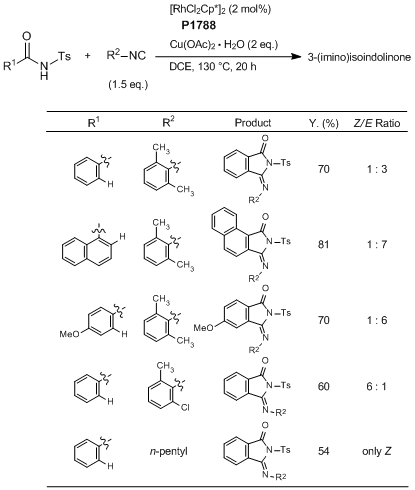Maximum quantity allowed is 999
Please select the quantity
CAS RN: 12354-85-7 | Product Number: P1788
(Pentamethylcyclopentadienyl)rhodium(III) Dichloride Dimer

Purity: >96.0%(T)
Synonyms:
- Dichloro(pentamethylcyclopentadienyl)rhodium(III) Dimer
- [RhCp×Cl2]2
Product Documents:
| Size | Unit Price | Same Day | 2-3 Business Days | Other Lead Time |
Shipping Information

|
|---|---|---|---|---|---|
| 200MG |
$164.00
|
30 | ≥60 | Contact Us | |
| 1G |
$637.00
|
≥60 | ≥100 | Contact Us |
* Please contact our distributors or
TCI
to order our products. The above prices do not include freight cost, customs, and other charges to the destination.
* The storage conditions are subject to change without notice.
| Product Number | P1788 |
| Purity / Analysis Method | >96.0%(T) |
| Molecular Formula / Molecular Weight | C__2__0H__3__0Cl__4Rh__2 = 618.07 |
| Physical State (20 deg.C) | Solid |
| Storage Temperature | Room Temperature (Recommended in a cool and dark place, <15°C) |
| Packaging and Container | 1G-Glass Bottle with Plastic Insert (View image), 200MG-Glass Bottle with Plastic Insert (View image) |
| CAS RN | 12354-85-7 |
| PubChem Substance ID | 87560640 |
| MDL Number | MFCD00061552 |
Specifications
| Appearance | Light yellow to Brown powder to crystal |
| Purity(Argentometric Titration) | min. 96.0 % |
Properties (reference)
GHS
| Pictogram |

|
| Signal Word | Warning |
| Hazard Statements | H302 + H312 + H332 : Harmful if swallowed, in contact with skin or if inhaled. H315 : Causes skin irritation. H319 : Causes serious eye irritation. |
| Precautionary Statements | P501 : Dispose of contents/ container to an approved waste disposal plant. P261 : Avoid breathing dust/ fume/ gas/ mist/ vapors/ spray. P270 : Do not eat, drink or smoke when using this product. P271 : Use only outdoors or in a well-ventilated area. P264 : Wash skin thoroughly after handling. P280 : Wear protective gloves/ protective clothing/ eye protection/ face protection. P337 + P313 : If eye irritation persists: Get medical advice/ attention. P305 + P351 + P338 : IF IN EYES: Rinse cautiously with water for several minutes. Remove contact lenses, if present and easy to do. Continue rinsing. P362 + P364 : Take off contaminated clothing and wash it before reuse. P332 + P313 : If skin irritation occurs: Get medical advice/ attention. P301 + P312 + P330 : IF SWALLOWED: Call a POISON CENTER/doctor if you feel unwell. Rinse mouth. P302 + P352 + P312 : IF ON SKIN: Wash with plenty of water.Call a POISON CENTER/doctor if you feel unwell. P304 + P340 + P312 : IF INHALED: Remove person to fresh air and keep comfortable for breathing. Call a POISON CENTER/doctor if you feel unwell. |
Related Laws:
Transport Information:
| H.S.code* | 2843.90-000 |
Application
Cp*-Rh catalyzed oxidative Heck reaction

References
- The Rhodium-catalyzed Selective Oxidative Heck Reaction of Amides with Allylic Esters
Application
Cp*-Rh catalyzed Direct Ar-H Sulfonamidation and Amination Reactions

References
- Rhodium(III)-catalyzed Direct C-7 Sulfonamidation and Amination of Indolines with Arylsulfonamides and Trifluoroacetamide
Application
Rhodium-catalyzed Annulation of N-Benzoylsulfonamide with Isocyanide through C―H Activation

Typical Procedure:
N-Benzoyl-4-methylbenzenesulfonamide (27.5 mg, 0.1 mmol), [RhCl2Cp*]2 (1.2 mg, 0.002 mmol) and Cu(OAc)2·H2O (40.0 mg, 0.2 mmol) are loaded in a dry vial which is subjected to evacuation/flushing with dry argon three times. A solution of 2,6-dimethylphenyl isocyanide (19.6 mg, 0.15 mmol) in anhydrous dichloroethane (0.8 mL) is syringed into the mixture that is then stirred at 130 °C for 20 h or until the starting material has been consumed as determined by TLC. Upon cooling to room temperature, all volatiles are evaporated and the residue is purified by preparative TLC (ethyl acetate : hexane = 1 : 2) to give the corresponding 3-(imino)isoindolinone derivative (Y. 70%, E/Z = 3 : 1). Z and E isomers are further separated by preparative TLC (methylene chloride : hexane = 10 : 1).
N-Benzoyl-4-methylbenzenesulfonamide (27.5 mg, 0.1 mmol), [RhCl2Cp*]2 (1.2 mg, 0.002 mmol) and Cu(OAc)2·H2O (40.0 mg, 0.2 mmol) are loaded in a dry vial which is subjected to evacuation/flushing with dry argon three times. A solution of 2,6-dimethylphenyl isocyanide (19.6 mg, 0.15 mmol) in anhydrous dichloroethane (0.8 mL) is syringed into the mixture that is then stirred at 130 °C for 20 h or until the starting material has been consumed as determined by TLC. Upon cooling to room temperature, all volatiles are evaporated and the residue is purified by preparative TLC (ethyl acetate : hexane = 1 : 2) to give the corresponding 3-(imino)isoindolinone derivative (Y. 70%, E/Z = 3 : 1). Z and E isomers are further separated by preparative TLC (methylene chloride : hexane = 10 : 1).
References
PubMed Literature
Articles/Brochures
TCIMAIL
Product Documents (Note: Some products will not have analytical charts available.)
Safety Data Sheet (SDS)
Please select Language.
The requested SDS is not available.
Please Contact Us for more information.
Specifications
C of A & Other Certificates
Please enter Lot Number
Incorrect Lot Number. Please input only the 4-5 alphanumeric characters before the hyphen.
Sample C of A
This is a sample C of A and may not represent a recently manufactured lot of the product.
A sample C of A for this product is not available at this time.
Analytical Charts
Please enter Lot Number
Incorrect Lot Number. Please input only the 4-5 alphanumeric characters before the hyphen.
The requested analytical chart is not available. Sorry for the inconvenience.



